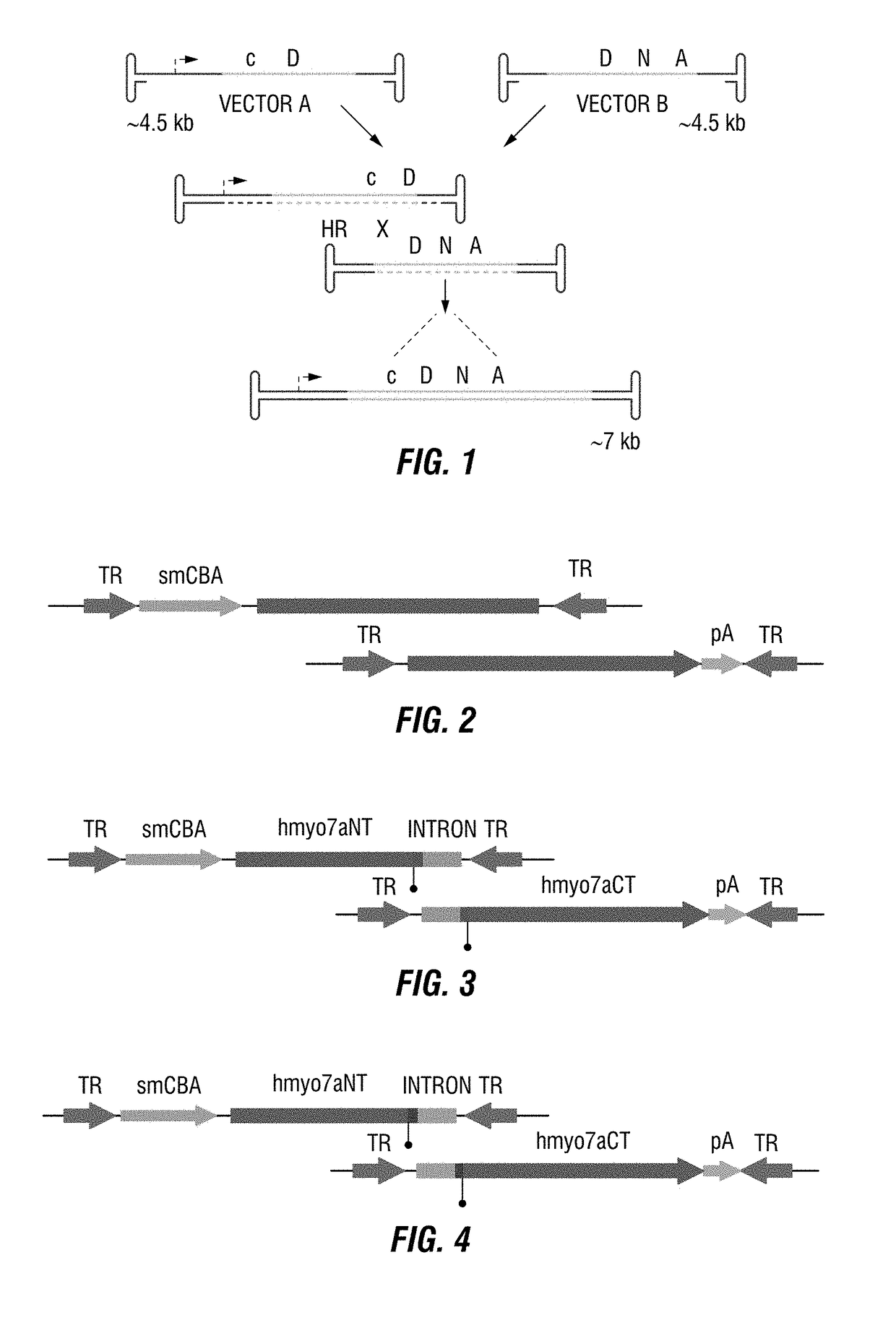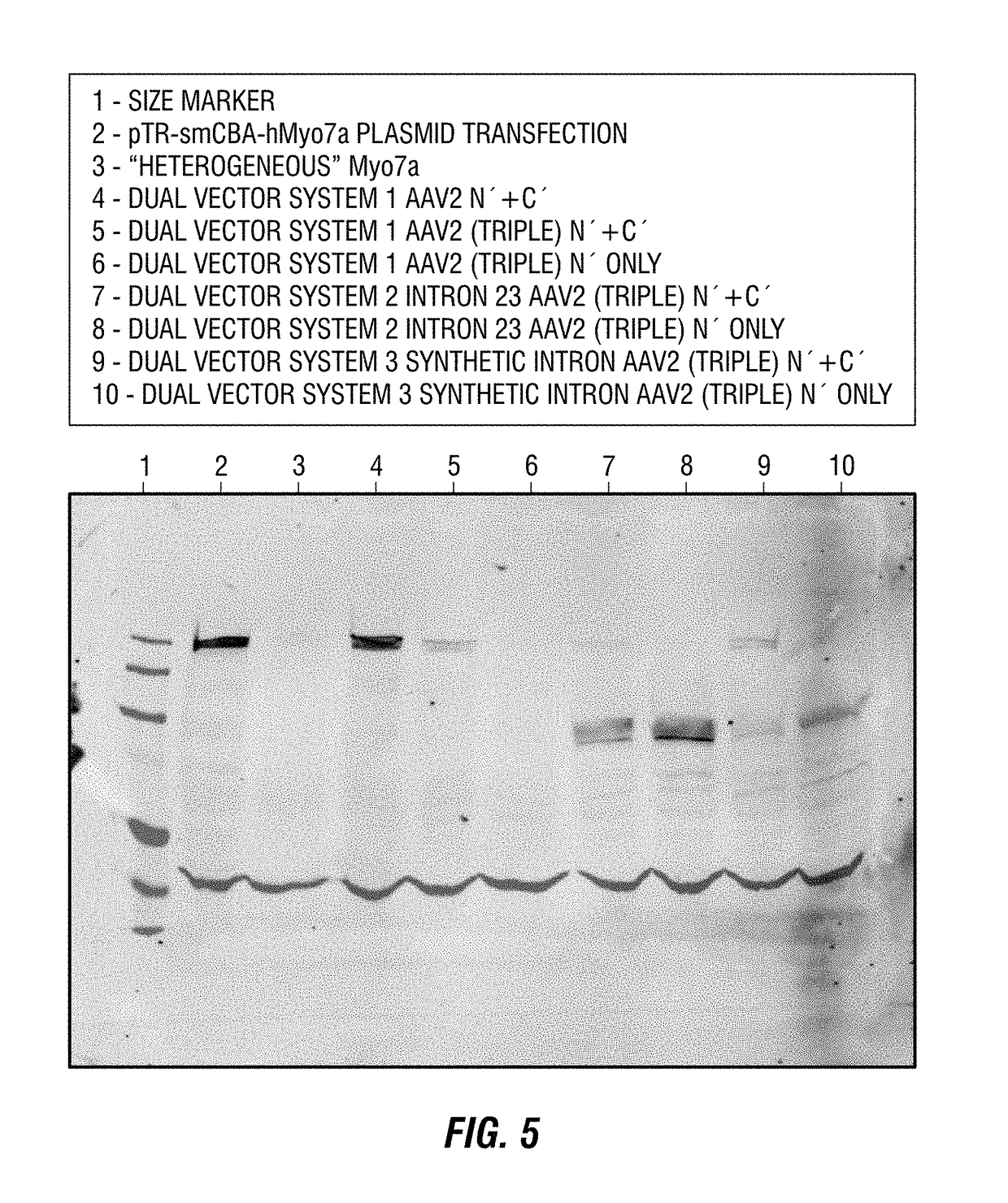Dual-AAV vector-based systems and methods for delivering oversized genes to mammalian cells
a gene and vector technology, applied in the field of molecular biology and virology, can solve the problems of unsuitable aav vector systems for gene therapy of ush1b, and relatively small dna packaging capacity,
- Summary
- Abstract
- Description
- Claims
- Application Information
AI Technical Summary
Problems solved by technology
Method used
Image
Examples
example 1
Vector System 1: hMyo7a Coding Overlap
[0144]In the case of Dual-Vector System 1 (FIG. 2) the overlapping DNA sequence shared by both vector A and vector B consists of a 1350-bp coding region for the human Myo7a gene. This is the simplest system of the present invention, and appears to be highly efficient in terms of full-length gene reconstitution, and MYO7A expression. Advantageously, each vector is of standard AAV packaging size, and as such, each packages DNA with a high degree of efficiency, and is readily adaptable to conventional GMP standards. Such vectors are also readily characterized to permit requisite regulatory approval prior to use in humans.
example 2
Vector System 2: hMyo7a Intron 23 Splicing
[0145]In the case of Dual-Vector System 2 (FIG. 3) the overlapping DNA sequence is composed of the native intron 23 of human Myo7a. Vector A contains the coding sequence corresponding to the amino-terminal portion of the hMyo7a cDNA relative to intron 23 (hMyo7aNT) and the native splice-donor site, followed by the entire intron 23 of hMyo7a (minus the native acceptor site). Vector B contains the carboxy-terminal portion of the hMyo7a cDNA relative to intron 23 (hMyo7aCT), and the full intron 23 of Myo7a (minus the native splice-donor site), followed by the native splice-acceptor site. Upon co-delivery to suitable mammalian host cells, the DNA of vectors A and B recombine to form a reconstituted full-length gene cassette. The resulting RNA transcript will then ‘splice out’ the native intron. Alternatively, recombination and formation of the gene cassette can occur via the AAV TRs. In this case, the RNA transcript will ‘splice out’ the native ...
example 3
Performance of System 1: hMyo7a Coding Overlap
[0146]HEK293 cells were infected simultaneously with vector A and vector B of Dual-Vector System 1 (FIG. 2) at a ratio of 10000:1 vg / cell for each vector. The AAV vectors were then packaged in AAV2 virions that contain three Y→F mutations in the capsid protein (see, for example, Zhong et al., 2008). As a positive control, cells were transfected with plasmid containing full-length hMyo7a under the control of smCBA. Protein was recovered from cells at 3-, 4-, 5-, 6- and 7-days' post-infection, and an antibody directed against MYO7A was used to assay for its presence in the infected cells via immunoblotting. The results are shown in FIG. 6A and FIG. 6B. The area inside the white box is magnified, and presented at higher contrast on the right. Starting at 3-days' post-infection, the full-length human MYO7a protein was visible; peak expression of the protein occurred around Day 5.
PUM
| Property | Measurement | Unit |
|---|---|---|
| time course | aaaaa | aaaaa |
| melting temperature | aaaaa | aaaaa |
| pH | aaaaa | aaaaa |
Abstract
Description
Claims
Application Information
 Login to View More
Login to View More - R&D
- Intellectual Property
- Life Sciences
- Materials
- Tech Scout
- Unparalleled Data Quality
- Higher Quality Content
- 60% Fewer Hallucinations
Browse by: Latest US Patents, China's latest patents, Technical Efficacy Thesaurus, Application Domain, Technology Topic, Popular Technical Reports.
© 2025 PatSnap. All rights reserved.Legal|Privacy policy|Modern Slavery Act Transparency Statement|Sitemap|About US| Contact US: help@patsnap.com



